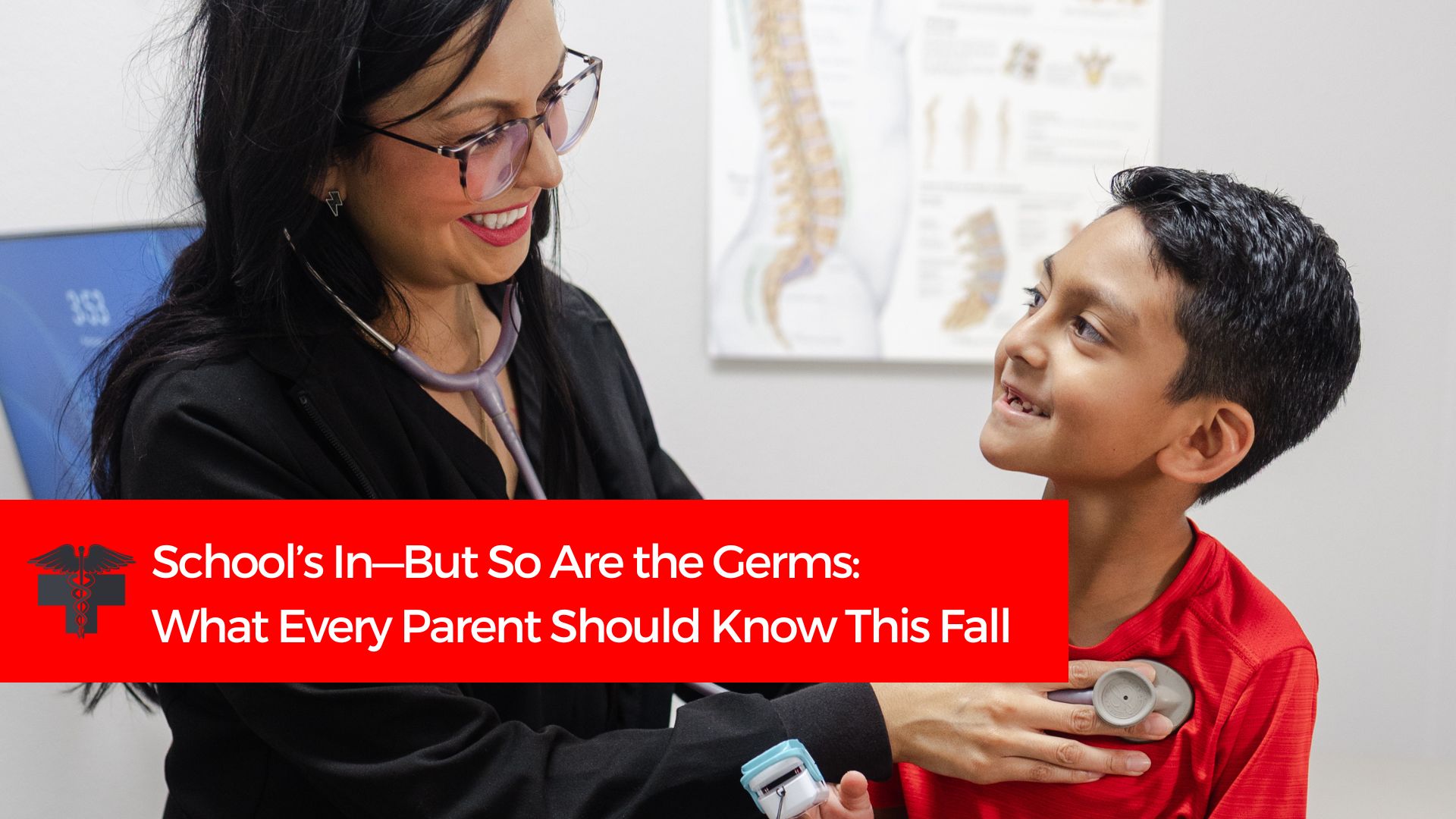Back-to-school season brings new teachers, fresh notebooks, and a schedule packed with activities but it also brings something far less welcome: germs.
When children return to classrooms, they’re suddenly in close contact with dozens (if not hundreds) of other kids. Shared supplies, high-touch surfaces, and still-developing hygiene habits create a perfect storm for illness.
Here are the top 5 back-to-school illnesses that most commonly sweep through classrooms and how you can help your child stay healthy all season long.
1. The Common Cold
Symptoms: Runny or stuffy nose, sneezing, mild fever, fatigue, sore throat, and occasional cough.
Why it spreads: Rhinoviruses are easily transmitted through the air and on surfaces (think shared crayons, desks, and doorknobs.)
Prevention Tips:
- Encourage regular handwashing with soap for at least 20 seconds (especially before eating and after recess or bathroom breaks).
- Teach kids to sneeze or cough into their elbow, not their hands.
- Send them with their own water bottle and remind them not to share.
Fun tip: Practice handwashing at home with a song; 20 seconds = about one round of “Twinkle Twinkle” or “Happy Birthday.”
2. Strep Throat
Symptoms: Sore throat, fever, swollen lymph nodes, white patches on the tonsils, and stomachache in younger children.
Why it spreads: Group A Streptococcus bacteria spread through respiratory droplets or contact with contaminated surfaces.
Prevention Tips:
- Don’t share forks, spoons, water bottles, or lip balm.
- If your child has a sore throat with a fever, don’t wait. Schedule a quick test. Untreated strep can lead to complications.
Note: Antibiotics can quickly treat strep, but your child should stay home for at least 24 hours after starting treatment to avoid spreading it.
3. Pink Eye (Conjunctivitis)
Symptoms: Red or pink, itchy eyes; watery or yellow/green discharge; crusty lashes (especially in the morning).
Why it spreads: Pink eye is highly contagious—whether viral or bacterial—and spreads easily via unwashed hands and shared items.
Prevention Tips:
- Reinforce the habit: “Don’t touch your eyes.”
- Provide hand sanitizer when soap isn’t nearby.
- Disinfect shared electronics (like tablets) and avoid sharing towels, pillowcases, or face cloths.
Bonus tip: If your child wakes up with gunky eyes, keep them home and call your doctor. Some cases require prescription drops.
4. Stomach Bugs (Gastroenteritis)
Symptoms: Nausea, vomiting, diarrhea, stomach cramps, and sometimes fever.
Why it spreads: Caused by viruses like norovirus and rotavirus, it spreads through contaminated hands, food, or surfaces.
Prevention Tips:
- Always wash hands before meals and after the restroom.
- Avoid shared snacks or drinks.
- Teach little ones not to put fingers or objects in their mouth unnecessarily.
Important: If your child is throwing up or has diarrhea, keep them home for at least 24 hours after symptoms stop to reduce spread.
5. Head Lice
Symptoms: Itchy scalp, tickling feeling, visible nits (eggs) near the scalp, especially behind ears or at the nape of the neck.
Why it spreads: Lice crawl (not jump) and spread through direct head-to-head contact and shared personal items.
Prevention Tips:
- Avoid sharing combs, brushes, hats, hair accessories, and headphones.
- Tie long hair back in braids or buns.
- Teach kids not to lean heads together during play or selfies.
Reminder: Lice are not a sign of poor hygiene. They’re just annoying and very common in school-aged children.
Start Strong: Prevention Is Key
Want to give your child the best chance at a healthy school year? Start with these:
- Schedule a back-to-school wellness check. This is a great time to check growth, mental health, and vision.
- Make sure vaccinations are current. Staying up to date protects your child and those around them.
- Teach (and model) good hygiene habits. Children are more likely to follow your lead.
- Talk about stress and emotions. Sometimes, “sick” can be emotional, not just physical. Don’t overlook the mental side of health—especially in older kids.
You’ve Got This
Back-to-school doesn’t have to mean back to the doctor every week. With a little preparation and some healthy habits, your child can thrive this year in mind and body.





 and then
and then